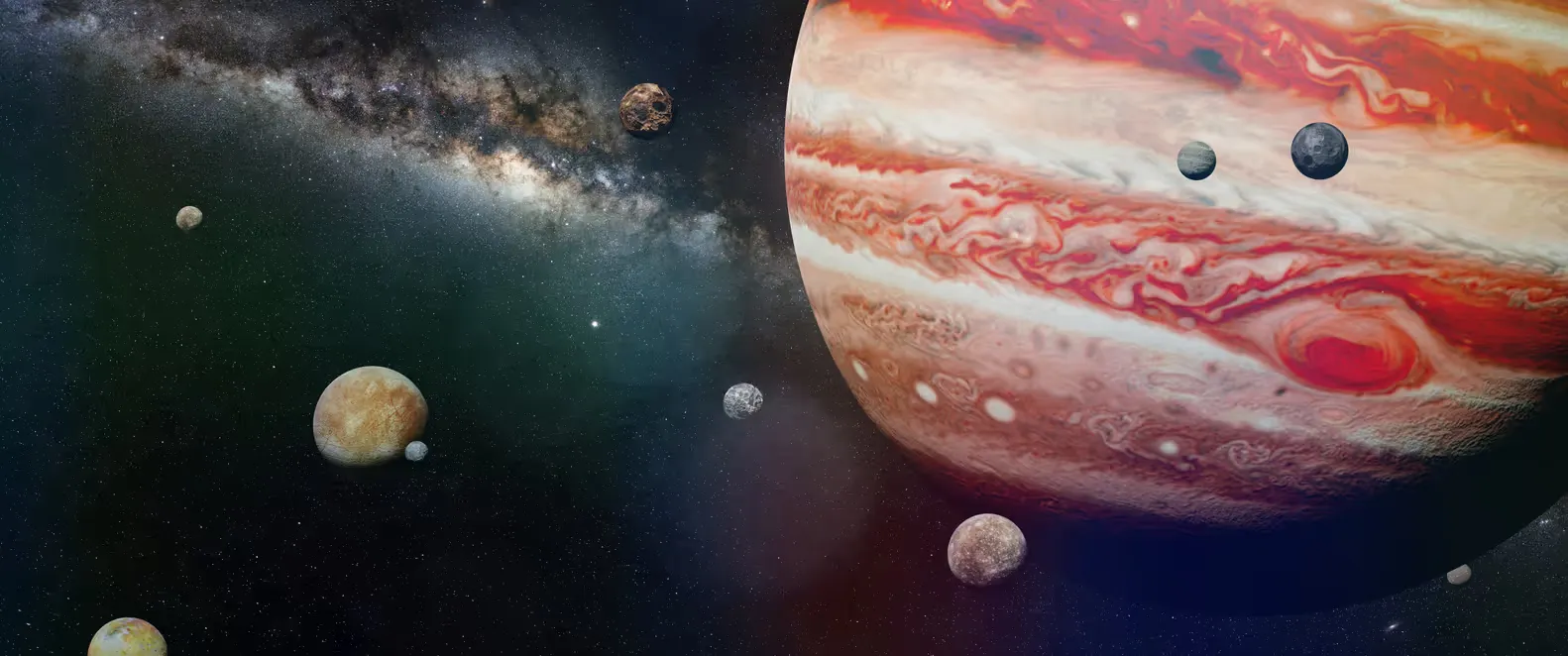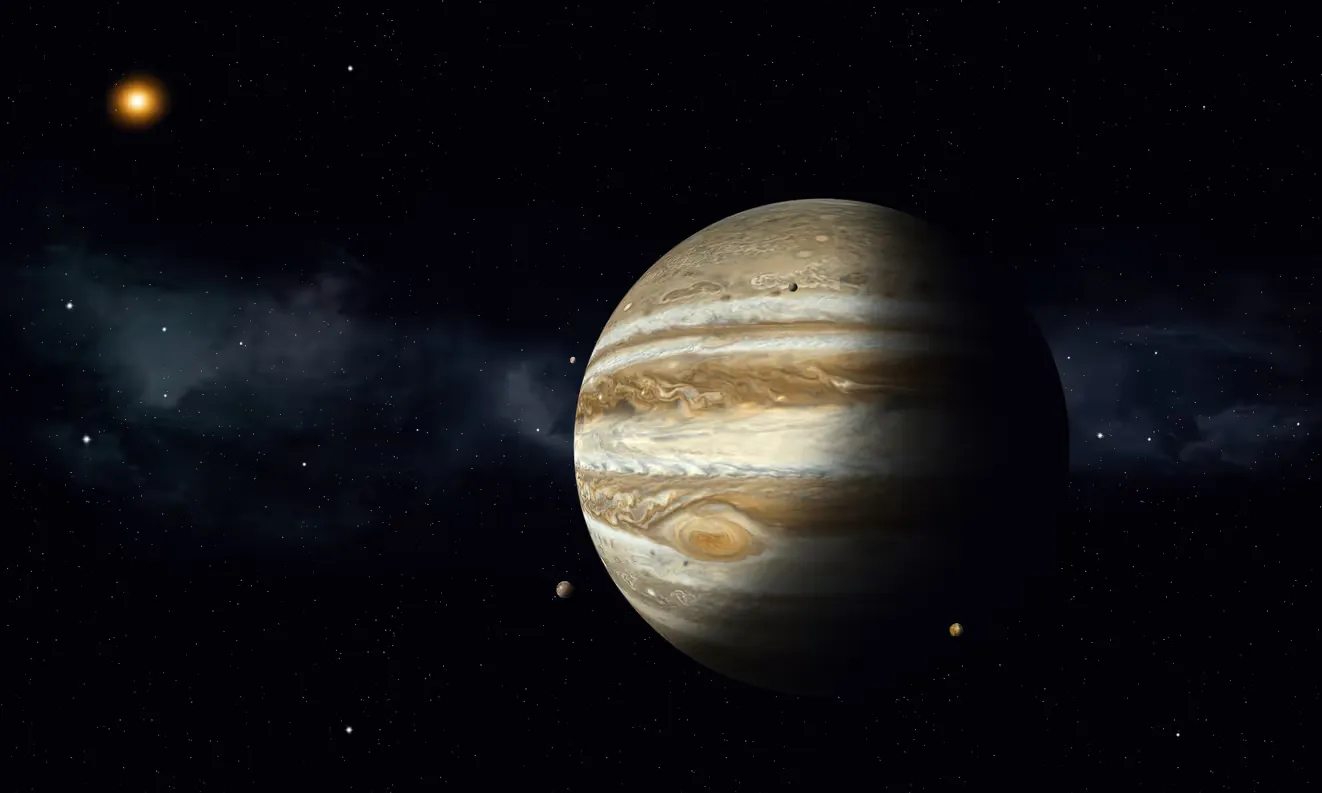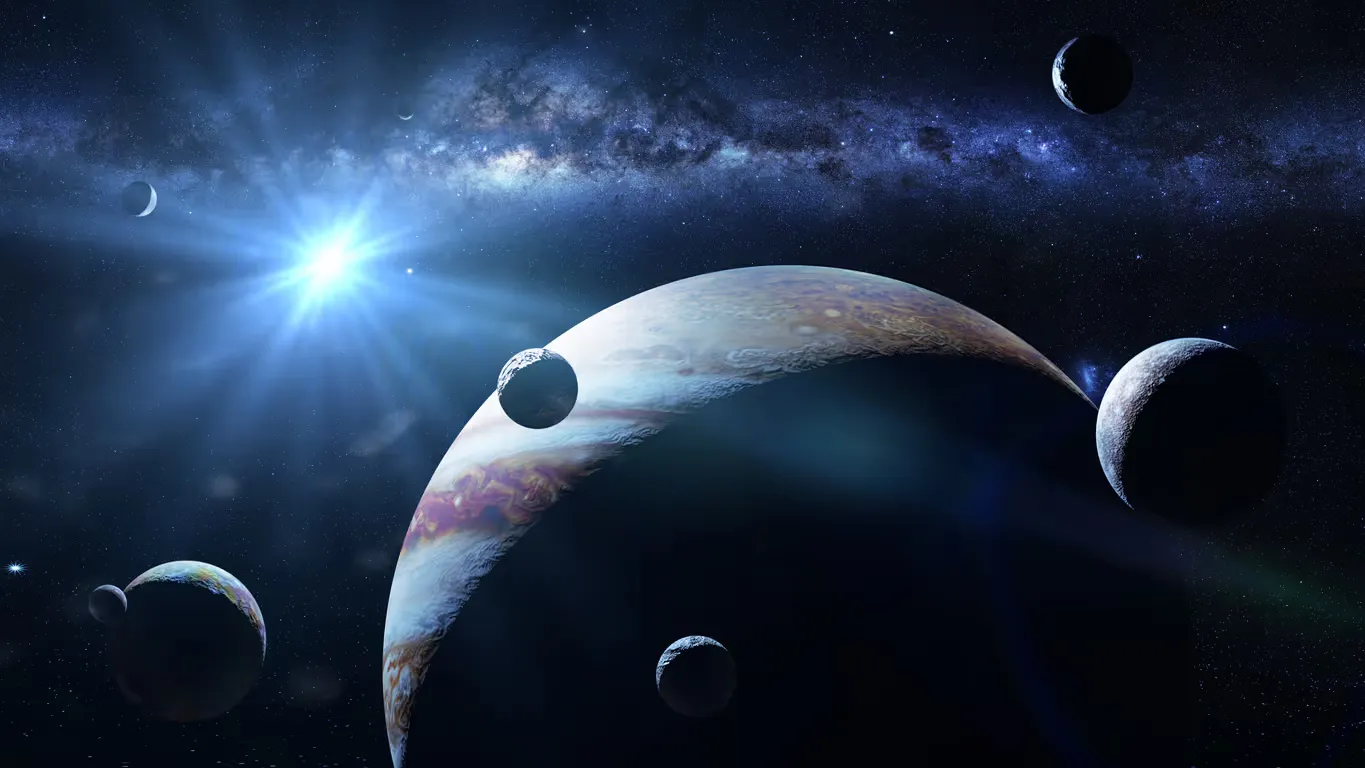JUICE spacecraft is set to explore Jupiter's moons
On April 13th, 2023 the European interplanetary station JUICE (Jupiter Icy Moons Explorer) is scheduled to launch into space. Its mission is to explore the Galilean moons of Jupiter searching for oceans.
At the start of 2023, the number of known moons around Jupiter has risen to 92. However, Io, Europa, Ganymede and Callisto remain the most interesting for astronomers. Discovered by Galileo Galilei in early 17th century, these moons have remained mysterious points of interest to planet-watchers for centuries until the first interplanetary probes finally reached them. To scientists' surprise, they found fountain eruptions of molten sulphur on Io, icy crust of Europa and marked by cracks and craters on Ganymede and Callisto.
Scientists suspected a couple of decades ago, through the study of data from the Voyager probe and Galileo station observations, that under the surfaces of Europa, Ganymede and Callisto could be hiding oceans of salty water. As an explanation for why these oceans would not freeze, it was hypothesized that the satellites were heated by the transformation of energy from deformation within their interiors due to tidal forces from Jupiter. Io, whose volcanic activity is also credited to Jupiter's tidal influence, may also have a subsurface ocean consisting of molten lava.

The oceans in Jupiter's system are interesting to astrobiologists as well. Earth-like ecosystems arising at hydrothermal vents (“black smokers”) on the ocean floor - oases of life that never receive sunlight - are known to scientists. There is even a theory that life on Earth originated in such conditions. It is also thought that massive, Earth-like moons of gas giant planets in other star systems might be potentially habitable for this same reason, due to tidal heating of their interiors.
Despite the fact that Jupiter's satellites have been observed from both Earth and near-Earth orbit for some time now, as well as with interplanetary probes, scientists still have more questions than answers about their characteristics, structure and evolution.

Ganymede
The main goal of JUICE is Ganymede, the largest and most massive satellite in the Solar System. It is larger than Mercury, Pluto and the Moon (and two times more massive than the latter).
Ganymede is unique among all the satellites of Jupiter in that it generates its own magnetic field, in addition to an induced field resulting from Jupiter's influence. Polar auroras have been observed on Ganymede, and charged particles actively bombard the icy polar caps, making its surface structure amorphous. Considering Ganymede is a differentiated body with massive layers, its magnetic field can be created similarly to Earth's—due to the movement of liquid conducting materials within its metallic core.
The first hints of an ocean on Ganymede were discovered by planetary scientists in 2000. They theorized that such a configuration of the satellite's magnetic field could be explained if there was an underlying layer of salty water beneath the 150-kilometer thick layer of ice and silicate rocks—up to one hundred kilometers deep. It is also possible that this ocean may be stratified, with alternating layers of water and ice at different depths. Later, the same orbital telescope provided indirect evidence for the hypothesis by detecting water vapor in Ganymede's atmosphere, though its source was linked to the icy surface rather than an underlying ocean.
Remembering that Ganymede has survived a collision with another large body, plus its tectonic activity, it makes it an interesting target for exploration. JUICE will initially observe Ganymede from flyby trajectories before settling into orbit around it.
The station: will study the satellite's magnetic field structure how charged particles interact with its surface and Jupiter's magnetosphere monitor its polar emissions measure the density and chemical composition of its atmosphere and ionosphere map its surface taking into account the chemical composition and properties of its surface describe subsurface layers as well as the internal structure of Ganymede, including any hypothetical ocean.
Europa and Callisto
Europe and Callisto are additional targets of the JUICE mission, whose spacecraft will conduct close flybys to study them. Callisto is the second largest satellite of Jupiter and third among all Solar System satellites. Initially, it was thought to be a dull mixture of rock and ice, but later data analysis from the Galileo spacecraft suggested that it may have a salty ocean beneath its surface at a depth of 250 kilometers or deeper. It also has a very thin atmosphere composed of carbon dioxide and oxygen.
As for Europe, it is alongside Saturn's moon Enceladus one of the most media-friendly candidates for having an underground ocean; it has even made its way into science fiction. Its existence was initially hinted at by the Voyager and Galileo spacecraft, and in 2016 Hubble spotted something resembling water plumes erupting from beneath its icy crust. This was later confirmed by archival data.
Today, the ocean kilometers deep which may lie beneath Europe's surface is considered potentially habitable.
During flybys of Callisto and Europe, JUICE:
- will analyze their chemical composition of their surfaces;
- estimate their ice layer thickness;
- determine parameters of any oceans present;
- describe their internal structures;
- observe the way they interact with Jupiter’s magnetosphere.
Special attention will be paid to Europe's observations for organic compounds important for life origins. Furthermore, JUICE will remotely monitor Jupiter itself, Io and other smaller satellites of Jupiter as well as its dusty rings.

The primary tools of the JUICE spacecraft
The research arsenal of JUICE consists of ten scientific instruments:
- an optical camera;
- a visible/infrared spectrometer;
- an ultraviolet spectrometer;
- a submillimeter wave instrument;
- a radiation environment sensor;
- a magnetometer;
- a laser altimeter;
- a subsurface radar;
- an instrument for registering plasma and radio waves;
- a particle detector;
- and two instruments for measuring the gravitational fields of satellites and studying their internal structure.
Nine instruments are created by the European Space Agency, while the ultraviolet spectrometer was developed by NASA. Two foldable cross-shaped solar batteries with a total area of 85 square meters will provide power to the station. According to plan, after launch from the Kourou spaceport on an Ariane 5 rocket, JUICE will spend six and a half years carrying out five gravitational maneuvers before entering its final trajectory towards Jupiter. There will be three maneuvers around Earth, one around Venus, and one around the Moon. JUICE is expected to arrive at Jupiter in July 2031 and will approach its targets one by one over the next three years. The mission plan includes 21 close flybys of Callisto, two of Europa, and 12 of Ganymede. In December 2034 JUICE will enter an orbit around the last satellite, where it will remain until September 2035.
After that, its trajectory is to be changed so that it crashes into the surface of a moon. Interestingly, JUICE has not been sterilized according to planetary protection rules since there is currently no evidence that the subsurface ocean of Ganymede, which could potentially be habitable, interacts with its surface. If JUICE disproves this idea then the European Space Agency may reconsider it.